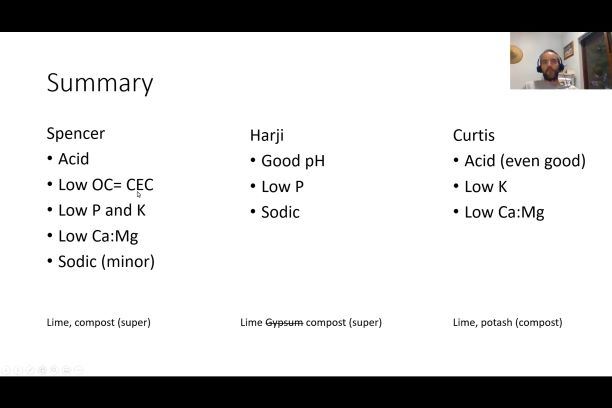At our online meeting Dr Jason Condon chatted with farmers Jennie Curtis, Allan Spencer and Harji Dhindsa about the soil test results from the demonstration plots on their farms.
Soil samples were taken from each farm in September from a ‘good patch’ and ‘bare patch’ of soil in the demonstration plots. The soil from the bare patch plots was bulked. The soil was sampled at depths 0-5, 5-10, 10-15 and 15-20cm to see what was going on in the different soil layers.
Jason discussed what the soil test results mean and the differences between the patches, soil depths and farms. We recommend you take the time to listen to Jason’s presentation. He explains how to interpret the soil test results including soil pH, aluminium, potassium, cation exchange capacity, organic carbon, exchangeable sodium percentage, soil electrical conductivity and calcium/magnesium ratio. He then goes on to suggest actions that can be taken to improve the soil health on each farm.
This meeting was recorded on the 16 November 2020 and you can view the video here.
Jason explained the demonstrations sites have their own unique factors that are limiting plant growth and contributing to the bare patches. It was fascinating to learn about how the “Law of the Minimum’ works in practice and how soil structure can affect plant growth.
Key messages from the meeting:
- Acidic soils are those with soil pH (measured in Calcium chloride, CaCl2) less than 5.5. The pH test in CaCl2 (pHCa) better mimics the soil conditions that plants are growing in compared to pH measured in pure water (pHw).
- When the soil pHCa is less than 5, the concentration of exchangeable aluminium (Al) in the soil increases. This aluminium can be toxic to plants and can take up valuable nutrient holding sites in the soil (called the cation exchange capacity, CEC) causing useful nutrients to be displaced from the topsoil. When the percentage of the CEC taken up by aluminium (Al%) is over 5% some plants and soil organisms will suffer aluminium toxicity however, even aluminium tolerant plants will still suffer from toxicity at Al% over 30.
- Legume rhizobia may not fix nitrogen if the soil pH is below 5. Two of the demonstration sites have very low pH that decreases at depth. The Al toxicity would be limiting the growth of plant roots in the surface layer, which means the plants will have less resilience to stress and die off sooner in spring as water becomes limiting.
- Low soil pH can affect the cycling of major nutrients including potassium and phosphorus. Correcting soil pH is a key way to improve nutrient cycling in the soil. Grazing animals cycle potassium and phosphorus through their urine and manures, if products such as hay, animal meat or fibre are removed then these nutrients are lost from the system and the fertility of the soil is reduced.
- When phosphorus (P) is low the plants become P deficient and growth will be limited. Even native grass pastures require a source of P (around 20 Colwell P), improved pastures require more P (around 30 Colwell P).
- Exchangeable Sodium Percentage (ESP) measures soil sodicity. If the ESP is above 6 then the soil is sodic. Soil sodicity causes soil dispersion that leads to erosion.
- When the calcium – magnesium ratio is low (below 2) the soil structure is not stable, this makes the pores smaller, the aggregates fall apart and slaking occurs. Slaking contributes to poor water infiltration because of the smaller soil particles. At depth where the Ca:Mg ratio is low, this can cause major soil slumping and potential erosion. The slaking at depth could also affect plant growth due to lack of oxygen and space for plant roots to grow.
This is a summary of the key differences between the project sites.

Resources
Soil Acidity and Liming AGFACT
Identifying dispersive sodic soils
Assessing soil aggregate stability
Cycling on phosphorus in grazing systems
You can catch up on the latest Grassing the Bare Patches Project here.
Dr Jason Condon is a soil scientist and educator from the Graham Centre for Agricultural Innovation, a partnership of NSW Department of Primary Industries and Charles Sturt University based in Wagga Wagga.
The Small Farms Network Capital Region received funding for this project from the Australian Government's National Landcare Program.